PIVOT! Now for something completely different….
Our next Art Journey Challenge #7 focuses on the lush floral still life paintings of celebrated 17th century Dutch artist Rachel Ruysch.
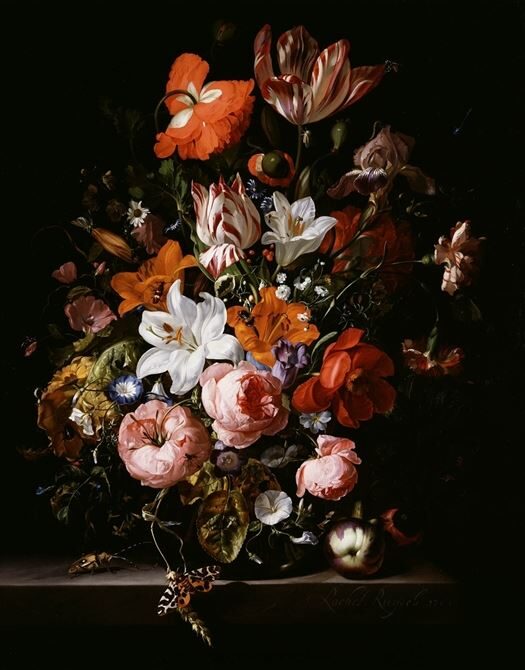
Rachel Ruysch was born June 3, 1664 into a creative and scholarly family. Her father Frederik was a professor of anatomy and botany. Her mother’s father was a renowned architect. And her uncle Franz was a landscape painter. Due to Frederik’s studies, he had a vast collection of animal skulls, insects, and botany examples that the young Rachel used to hone her drawing skills. Frederik’s collections included a five-room “cabinet of curiosities” that became a tourist attraction in Amsterdam. This chamber featured embalmed and wax-injected organs, animals, plants, and countless other oddities which he posed in artful, macabre dioramas (for instance, in one, a baby’s hand holds a turtle egg as it hatches) many of which Rachel helped to arrange for display. Frederik also collected art and was fond of the dark and moody sottobosco style (literally “thick undergrowth”) of local painter Otto Marseus van Schrieck whose paintings featured dark, fungi- and insect-glutted forest floors. When Van Schrieck died, Frederik bought up many of his paintings as well as preserved butterflies from his collection. Ruysch’s father nurtured his daughter’s natural flair for art from an early age, encouraging her to create careful studies from his extensive collections or based on his detailed scientific illustrations. This was all fertile ground for this budding artist.
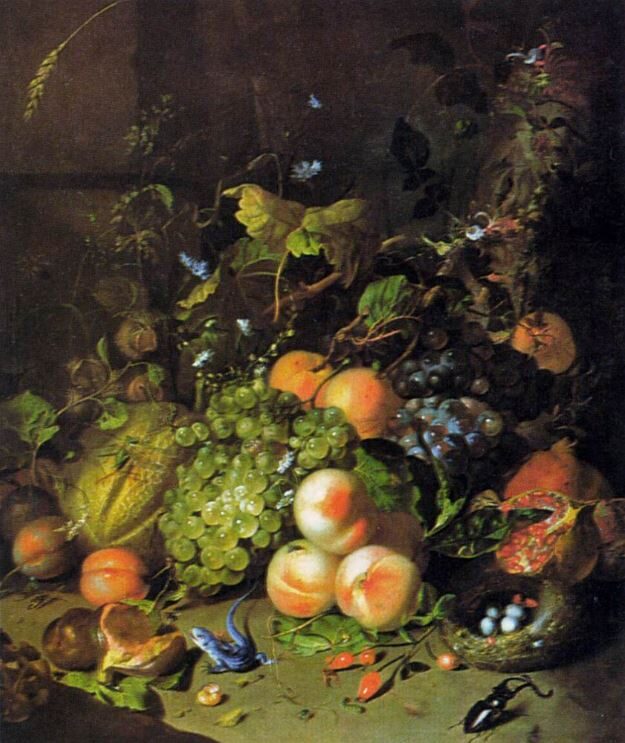
At the age of 15 Rachel got a rare opportunity for a young woman of the time, and was apprenticed to a noted Amsterdam painter, Willem van Aelst, who specialized in painting still life with flowers or game. From Van Aelst, Rachel learned not only how to paint the flowers faithfully, but also how to position the still life bouquets into spontaneous, haphazard and less formal arrangements which contributed to the almost realistic three-dimensional look of her works. By the time Ruysch was 18 she was selling signed works independently, which was quite unheard of because very few women were professional artists in the 1600s. Women were expected to pursue the more “womanly” arts of sewing and spinning, but another role model, Maria van Oosterwijck, influenced her work in floral paintings and pursuing an art career.
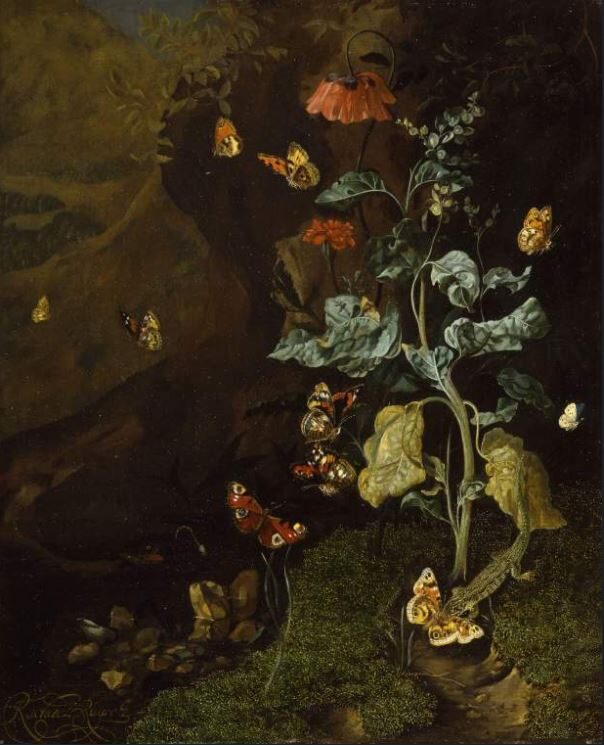
At the age of 29, Rachel Ruysch married Amsterdam portrait painter Juriaen Pool and started having a family. But unlike her sister Anna who was also a gifted artist, Rachel kept painting. She was so well-established by the time she married that she kept her maiden name. Throughout her marriage, including raising 10 children, she continued to paint and produce commissions, each taking months to finish, which must have been quite a feat as a working mother. She garnered very rich patrons, including Duke Johann Wilhelm II in Düsseldorf, after he visited the curiosity museum of Rachel’s father. Upon being transfixed by Ruysch’s inventive and intriguing worlds, it is no wonder that the Duke offered her the position as Court Painter.
Rachel showed tremendous sway with her wealthy benefactor and bucked the tradition of moving to court. Instead she convinced Johann Wilhelm to allow her to bring one painting a year to him so she could continue to raise her family in Amsterdam. (Her 10th and last child was born when she was 49, named Jan Wilhelm after her patron, who became Wilhelm II’s godson.) But the fact that she had such a following internationally at that time surely allowed her to continue the pursuit of art and also subsidize the family income to allow for hiring childcare help even after the Duke passed away.
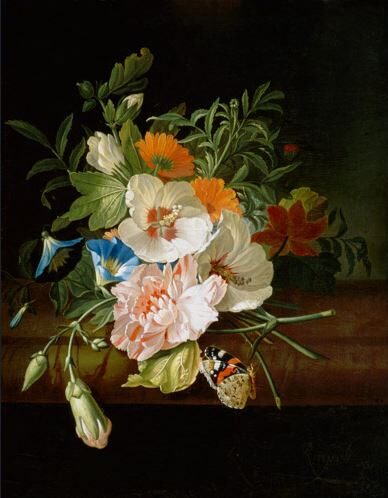
Ruysch’s style was part of the rococo movement, ornamental and lavish with acute attention to details, playful compositions and brilliant colors. Early in her career she would paint popular forest floor depictions featuring butterflies, reptiles and other small animals and even fungi. She was meticulous in capturing the life-like details. Every petal she painted was carefully placed and rendered. Her process included laying down the broad strokes of the composition and then going back with fine brushes and adding the detailed observations of each flower rendering them in the most realistic and natural way: tiny insects with patterned backs and translucent wings; bug-bitten leaves and needle-thin blades of grass; bees drunk on pollen burrowing into the folds of petals; gracefully arching arrangements with fragile blooms that defy space and time. The dark backgrounds used were the norm in this sottobosco style and really enhanced the explosions of color. She was even known to stamp texture on the paintings using moss and butterfly wings. The asymmetrical compositions including drooping flowers and wild stems make them teem with life and vibrancy while also alluding to the transience of nature and the mortality of all living things.
In the painting below you see her breadth of botanical knowledge in capturing the beauty of the poppy from underneath as the focal, along with a dying carnation and various buds about to burst. Her masterful use of light and shadow is astounding and brings each botanical subject into stark relief apart from the dark and brooding backdrop. She was known to blend botanical specimens from various places around the world and incompatible blooming seasons into wildly fantastical scenes.
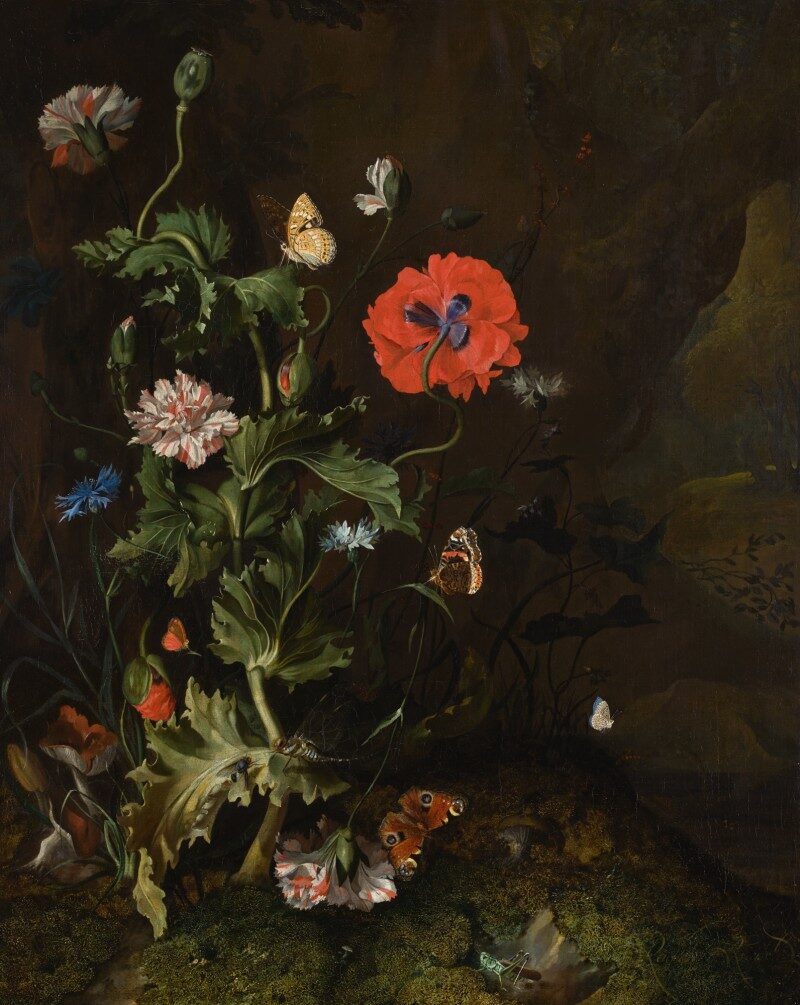
Ruysch enjoyed sustained fame throughout her lifetime. During the 17th century, the Dutch were obsessively interested in flowers and gardening, so paintings such as hers that spotlighted the intense beauty of nature were in high demand. Her paintings were sold as high as 750-1200 guilders each (in contrast, Rembrandt’s paintings rarely garnered 500 guilders in his lifetime) She is regarded as a renowned flower painter whose skill was unmatched. When she died in 1750, eleven poets paid their respects through verse.
Rachel Ruysch is considered by art historians to be one of the most talented still life artists. Not just female artists, but of all artists. Period. She produced hundreds of paintings over her long life, from the age of 15 until her death at the age of 86, and her signature typically included the age at which she painted it.
In 1999, a Ruysch painting (below) was discovered in Normandy in a common farmhouse. It was sold at auction for 2.9 million francs (or the equivalent of $508,000 US).
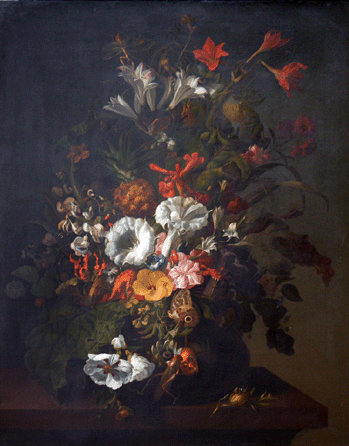
Rachel Ruysch teaches us that a woman could certainly do it all and have it all and that in those flowers lies a strong power!
What is the Art Journey Challenge?
Every six weeks or so we will challenge our readers to create jewelry inspired by the featured artwork or collection of art or theme. Use any or all of the artworks as your guide to the challenge: color, theme, motif, style, etc. You have until the end of the Art Journey period to share your work and then we pick one winner to receive beads and jewelry-making supplies from our editors and sponsors that will work with our NEXT Art Journey to hopefully inspire you to continue joining the challenges. Our only rule?
You must use at least one art bead in your piece!
We need to emphasize that all art provided on the Art Bead Scene is for inspiration and education only. No art may be downloaded or replicated in your art. Please bear that in mind.
How to Enter the Monthly Jewelry Challenge:
Create something using an art bead that fits within our monthly theme. This challenge is open to jewelry-makers, fiber artists, collage artist, etc. The art bead can be created by you or someone else. The challenge is to inspire those who use art beads and to see all the different ways art beads can be incorporated into your handiwork. An art bead must be used in your piece to qualify for the monthly challenge. Upload your photo to our photo album. Include a short description, who created the art beads and a link to your blog or shop, if you have one.
NEW! Entries will now be posted at our Art Bead Scene Lounge page on Facebook! Go to the Albums, find the one corresponding to the current Art Journey challenge, and post your images there. Remember that each entry is a chance to win! Be sure to add the hashtag #artjourney7 to your post.
Deadline to enter is Saturday, October 16th.
You may upload as many entries as you like per Art Journey, as long as they follow the guidelines. (Please be patient as they are approved by one of our editors to post in the Album). Our prize for Art Journey #7 will be given away from a random draw of all entries on October 18th with our prize package donated by Loralee Kolton that will be perfect for use with the Art Journey #8! We hope this will encourage you to play along!
Monthly Challenge Winners
• One prize winner will be selected at random from all pictures posted in our new Facebook albums!
• The winner will be randomly chosen from all the qualifying entries on October 18th.
• Be sure to point out all the art bead artists in your work in the description of the photos when you upload to the new gallery. Links to their website or shop are appreciated. That way we can all find new art beads to love!
What is an Art Bead?
An art bead is a bead, charm, button or finding made by an independent artist. Art beads are the vision and handiwork of an individual artist.
***A bead that is handmade is not necessarily an art bead. Hill Tribe Silver, Kazuri ceramic beads or lampwork beads made in factories are examples of handmade beads that are not considered art beads. Beaded beads, stamped metal pendants or wire-wrapped components are not considered art beads for our challenge.***
Bead Artists
Feel free to share beads that you made inspired by our challenge in our gallery. You can enter multiple submissions for each challenge. We love to promote new artists and share what you’ve created! Be sure to add some links so that we can know where to find more of your art beads!

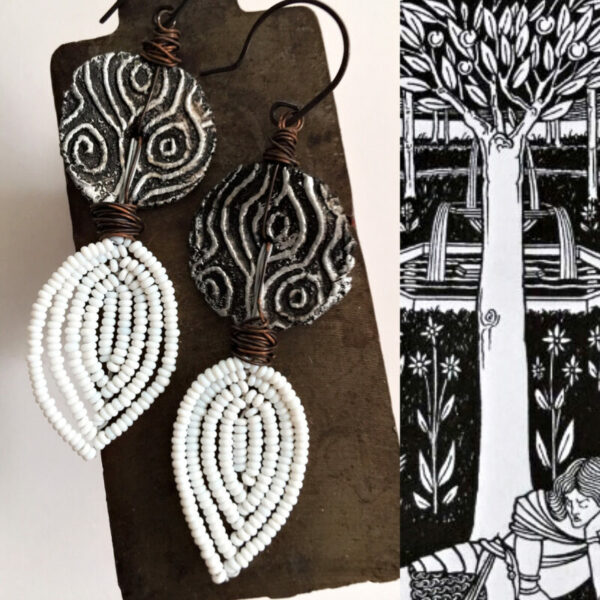
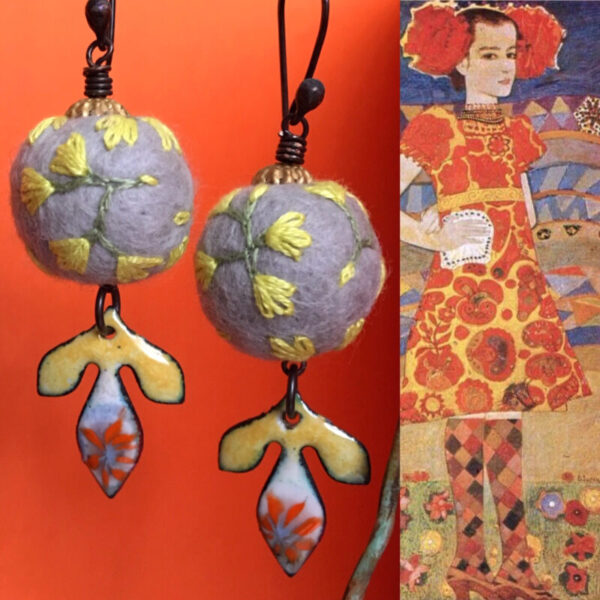
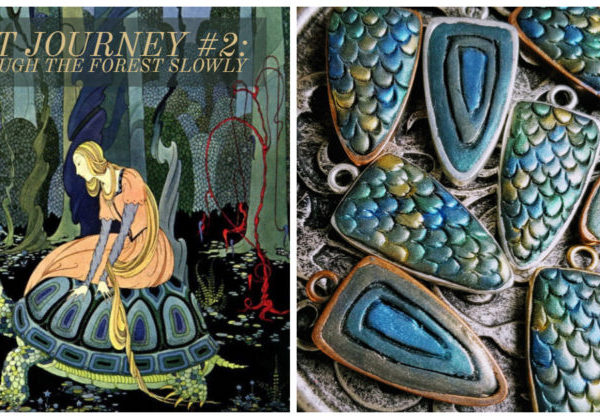
How to turn a bracelet focal into a necklace | Jewels of Sayuri
October 10, 2020 at 10:37 am[…] shining light on yet another incredible female artist. You can see several of her paintings in the Art journey challenge post here. The one that I have chosen as my inspiration is the “Still life of a thistle between […]
How to turn a bracelet focal into a necklace – autos
October 17, 2020 at 1:17 pm[…] shining light on yet another incredible female artist. You can see several of her paintings in the Art journey challenge post here. The one that I have chosen as my inspiration is the “Still life of a thistle between […]